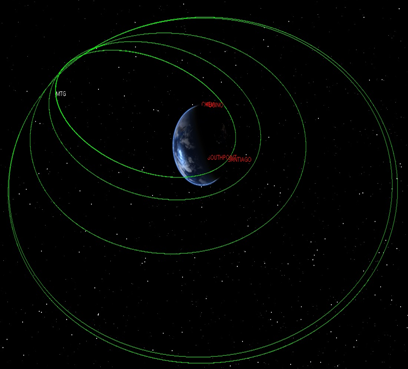From the Kourou launch platform to geostationary orbit: an eleven-day voyage that will be managed by Telespazio from Fucino Space Center, Italy.
This is the destiny of the first Meteosat Third Generation (MTG) satellite, due to take off from the base in French Guyana on Tuesday, 13 December at 21:30 (CET) on board an Arianespace Ariane 5 launch vehicle.
Fucino Space Center will establish contact with the MTG-I1 24 minutes after take-off, when the satellite starts sending signals from within the launcher.
Following the separation from the rocket, eleven minutes later, the Fucino center will be a hive of activity as the satellite automatically starts coming to life. In the hour following the launch, the satellite will, in order, open its solar panels, start charging its batteries, and begin preparing its engine.
The next day, the satellite will begin the ascent phase, which – thanks to four different engine ignitions – will gradually change the altitude and shape of its orbit: from an initial elliptical orbit in which the point closest to Earth is at an altitude of 200 kilometres to its final circular geostationary orbit about 36 thousand kilometres from the planet’s surface.

MTG-I1 will consume a total of approximately 1500 kg of fuel in this phase, a good part of the 2.2 tonnes it carries on board.
This is one of the most critical moments in a space mission, especially when transferring to a geostationary orbit: perfect execution of LEOP permits optimisation of fuel consumption, saving fuel for operations so as to maximise the data returned and the overall economic investment.
During its ascent into geostationary orbit, radio contact between the Fucino Space Center and the satellite will be guaranteed by a network of antennas ensuring global coverage: from Malindi, Kenya to Santiago, Chile, from Yatharagga and Dongara in Australia to South Point, Hawaii.
The final date for MTG-I1 LEOP will be eleven days after the launch date, on 24 December. Following final configuration of the propulsion system and insertion in the assigned geostationary slot, the satellite will at last unfurl its antennas to begin transferring weather data and start pointing its instruments towards Earth.
From here on, control of the satellite will be handed over to the Eumetsat control center in Darmstadt, Germany, where, following the subsequent testing and calibration phase, the MTG-1I will be managed as it carries out its true work of revolutionising weather forecasting and monitoring potential extreme weather events with the aid of the innovative Lightning Imager, an instrument developed by Leonardo to detect rapid flashes of lightning in the atmosphere.
A five-year LEOP
While MTG-I1’s LEOP lasts “only” 11 days, the work that went into its preparation started well before this, in May 2017.
Since that date, Telespazio technicians have been working on development of all the procedures, since shared with its partners – particularly Thales Alenia Space and OHB, who were in charge of the satellite’s construction – in a number of validation and simulation sessions.
Telespazio engineers developed a total of about 600 flight procedures permitting management of nominal mission phases and recovery of any anomalies.
Numerous teams were involved: analysis of on-board telemetry and remote control is centralised in the Fucino Space Center, performed by 18 engineers on Telespazio’s Satellite Control Team. Calculation of manoeuvres in orbit and coordination of ground antennas are performed by the Flight Dynamics and Ground Station Network teams, respectively. A total of about 40 Telespazio technicians are involved in MTG-1I operations.
On the evening of 13 December, in the Fucino Space Center, Telespazio technicians will complete 5 years of work essential to allow the MTG-1I satellite to reach its orbit as efficiently as possible, maximising the weather information it will send us in the years to come.

